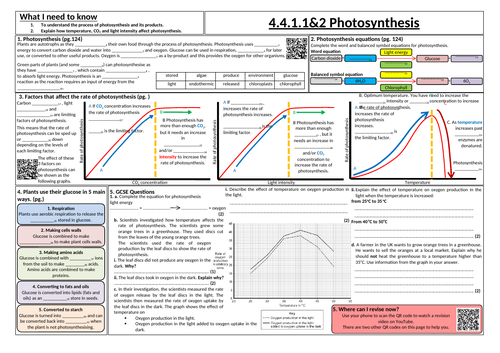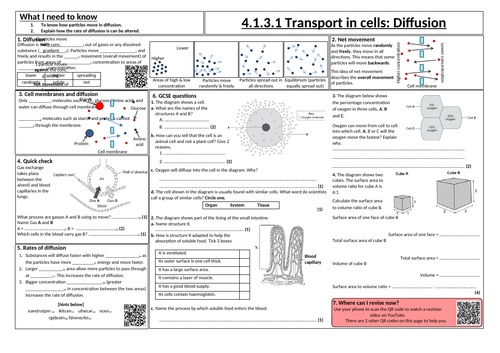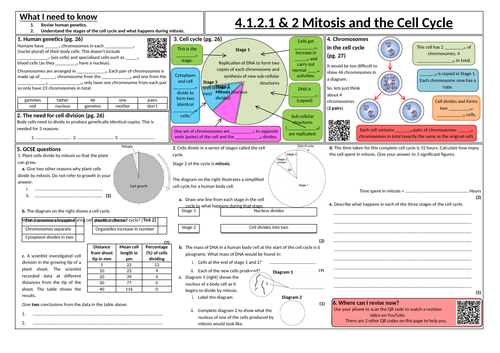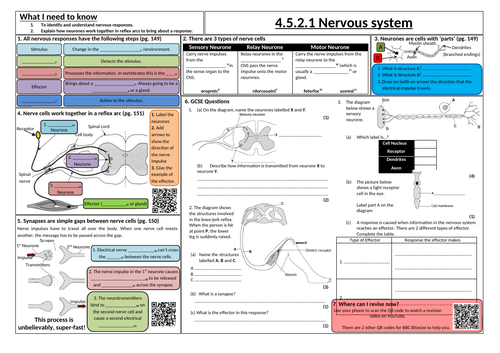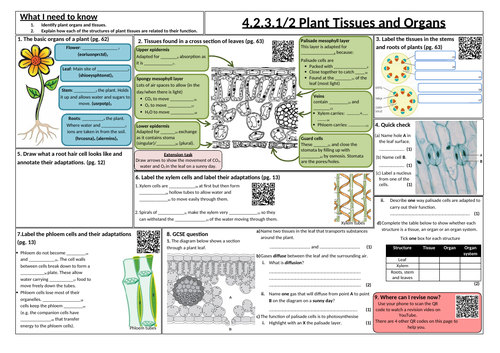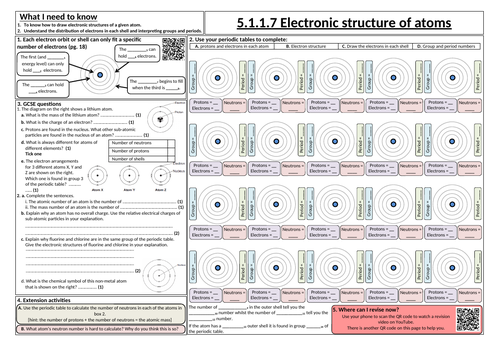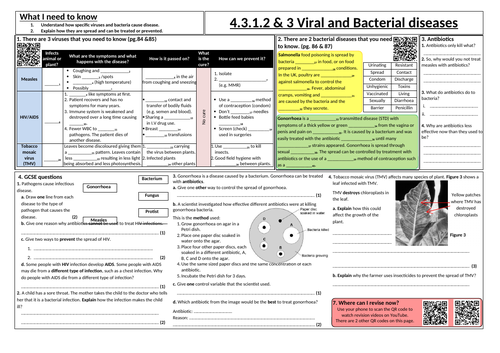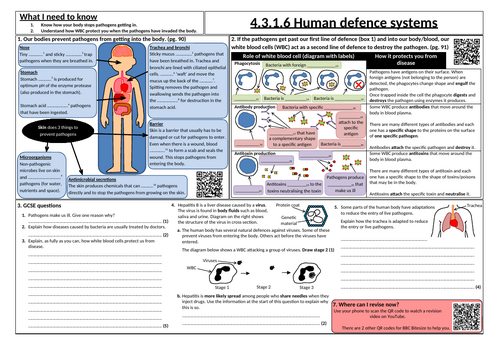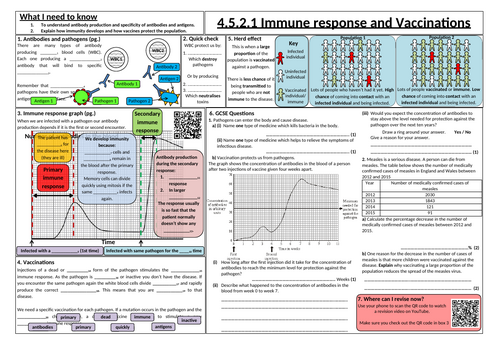
42Uploads
4k+Views
524Downloads
All resources

Transport in cells: Osmosis
Knowledge organiser designed to be printed in A3, however smaller scales (A4) can be used. The resource is constructed to be used for class work, independent/group learning through the sign-pointed references to textbooks, revision guides and web sites. The page numbers stated in each box can be easily adjusted to other reading/research materials.
The scaffolded work starts with appropriate notes on osmosis definition, permeable membranes, effect of solute concentration on water concentration, turgity of plant cells, flaccid and plasmolysis, examples of osmosis, osmosis in animal cells, prediction of osmosis in plant cell diagrams and ends with GCSE questions.
Embedded QR codes take the student to appropriate revision sites (YouTube and BBC Bitesize).
Mark scheme is included for all answers.

Heart problems
Knowledge organiser designed to be printed in A3, however smaller scales (A4) can be used. The resource is constructed to be used for class work, independent/group learning through the sign-pointed references to textbooks, revision guides and web sites. The page numbers stated in each box can be easily adjusted to other reading/research materials.
The scaffolded work starts with coronary heart disease (CHD), treating CHD (stents and statins), replacement valves, artificial pacemakers, replacement hearts and ends with past paper GCSE questions.
Embedded QR codes take the student to appropriate revision sites (YouTube and BBC Bitesize).
Mark scheme is included for all answers.

Response to Exercise and Metabolism [foundation tier]
Knowledge organiser designed to be printed in A3, however smaller scales can be used. The resource is constructed to be used for class work, independent/group learning through the sign-pointed references to textbooks, revision guides and web sites. The page numbers stated in each box can be easily adjusted to other reading/research materials.
The scaffolded work starts with how the breathing and circulatory system responds to exercise, metabolism (including examples) and ends with past paper GCSE questions.
Embedded QR codes take the student to appropriate revision sites (YouTube and BBC Bitesize).
Mark scheme is included for all answers.

Heart and Double Circulatory System
Knowledge organiser designed to be printed in A3, however smaller scales (A4) can be used. The resource is constructed to be used for class work, independent/group learning through the sign-pointed references to textbooks, revision guides and web sites. The page numbers stated in each box can be easily adjusted to other reading/research materials.
The scaffolded work starts with the structure of the heart, heart notes, double circulatory system, extension activities and ends with past paper GCSE questions.
Embedded QR codes take the student to appropriate revision sites (YouTube and BBC Bitesize).
Mark scheme is included for all answers.

Fungal and Protist diseases
Knowledge organiser designed to be printed in A3, however smaller scales can be used. The resource is constructed to be used for class work, independent/group learning through the sign-pointed references to textbooks, revision guides and web sites. The page numbers stated in each box can be easily adjusted to other reading/research materials.
The scaffolded work starts with appropriate notes on rose black spot, malaria and how to disrupt the life cycle of mosquitoes (vectors for the plasmodium) and ends with GCSE questions.
Embedded QR codes take the student to appropriate revision sites (YouTube and BBC Bitesize).
Mark scheme is included for all answers.

Plant organisation
Plant organisation PowerPoint that links with the animal and plant cell structures work sheet, plant leaf organisation knowledge organiser and You Say We Pay plenary activity at the end.
The animal and plant cell sheet includes an extension activity and a QR code that will take students to BBC Bitesize for revision and research.

Translocation and Transpiration
Knowledge organiser designed to be printed in A3, however smaller scales can be used. The resource is constructed to be used for class work, independent/group learning through the sign-pointed references to textbooks, revision guides and web sites. The page numbers stated in each box can be easily adjusted to other reading/research materials.
The scaffolded work starts with how plants use water, transpiration stream, factors affecting transpiration, potometers, guards cells and ends with past paper GCSE questions.
Embedded QR codes take the student to appropriate revision sites (YouTube and BBC Bitesize).

Aerobic and Anaerobic respiration
Knowledge organiser designed to be printed in A3, however smaller scales can be used. The resource is constructed to be used for class work, independent/group learning through the sign-pointed references to textbooks, revision guides and web sites. The page numbers stated in each box can be easily adjusted to other reading/research materials.
The scaffolded work starts with appropriate aerobic respiration note, aerobic respiration word and balanced symbol equations, the need for respiration, anaerobic respiration in animals/plants& fungi, anaerobic respiration word equations and ends with past paper GCSE questions.
Embedded QR codes take the student to appropriate revision sites (YouTube and BBC Bitesize).
Mark scheme is included for all answers.

RPA Photosynthesis [pondweed - higher tier]
Knowledge organiser designed to be printed in A3, however smaller scales can be used. The resource is constructed to be used for class work, independent/group learning through the sign-pointed references to textbooks, revision guides and web sites. The page numbers stated in each box can be easily adjusted to other reading/research materials.
The scaffolded work starts with the methodology, YouTube based experiment simulation, record of results, illustrating work in graph form, conclusion of results, control factors and experiment improvements.
In addition to the foundation based RPA Photosynthesis sheet, this sheet covers the inverse square law and how distance affects the light intensity and therefore the rate of photosynthesis.
Embedded QR codes take the student to appropriate revision sites (YouTube and BBC Bitesize).
Mark scheme is included for all answers.

RPA Photosynthesis [pondweed]
Knowledge organiser designed to be printed in A3, however smaller scales can be used. The resource is constructed to be used for class work, independent/group learning through the sign-pointed references to textbooks, revision guides and web sites. The page numbers stated in each box can be easily adjusted to other reading/research materials.
The scaffolded work starts with the methodology, YouTube based experiment simulation, record of results, illustrating work in graph form, conclusion of results, control factors and experiment improvements.
Embedded QR codes take the student to appropriate revision sites (YouTube and BBC Bitesize).
Mark scheme is included for all answers.

Photosynthesis, limiting factors and uses of glucose
Knowledge organiser designed to be printed in A3, however smaller scales can be used. The resource is constructed to be used for class work, independent/group learning through the sign-pointed references to textbooks, revision guides and web sites. The page numbers stated in each box can be easily adjusted to other reading/research materials.
The scaffolded work starts with the photosynthesis notes, photosynthesis equations, limiting factors of photosynthesis (including annotated graphs), how the plant uses its glucose and ends with past paper GCSE questions.
Embedded QR codes take the student to appropriate revision sites (YouTube and BBC Bitesize).
Mark scheme is included for all answers.

Transport in Cells: Diffusion
Knowledge organiser designed to be printed in A3, however smaller scales can be used. The resource is constructed to be used for class work, independent/group learning through the sign-pointed references to textbooks, revision guides and web sites. The page numbers stated in each box can be easily adjusted to other reading/research materials.
The scaffolded work starts with the diffusion notes, concept of net movement, cell membranes and diffusion, factors that affect diffusion and ends with past paper GCSE questions.
Embedded QR codes take the student to appropriate revision sites (YouTube and BBC Bitesize).
Mark scheme is included for all answers.

Mitosis and the cell cycle
Knowledge organiser designed to be printed in A3, however smaller scales can be used. The resource is constructed to be used for class work, independent/group learning through the sign-pointed references to textbooks, revision guides and web sites. The page numbers stated in each box can be easily adjusted to other reading/research materials.
The scaffolded work starts with appropriate notes on human genetics, the need for cell division, the cell cycle stages, what happens to the chromosomes at each stage and ends with GCSE questions.
Embedded QR codes take the student to appropriate revision sites (YouTube and BBC Bitesize).
Mark scheme is included for all answers.

Human nervous system
Knowledge organiser designed to be printed in A3, however smaller scales (A4) can be used. The resource is constructed to be used for class work, independent/group learning through the sign-pointed references to textbooks, revision guides and web sites. The page numbers stated in each box can be easily adjusted to other reading/research materials.
The scaffolded work starts with coordination, 3 types of neurones, reflex arcs, synapses and ends with past paper GCSE questions.
Embedded QR codes to take the student to appropriate revision sites (YouTube and BBC Bitesize).
Mark scheme is included for all answers.

Plant tissues and organs
Knowledge organiser designed to be printed in A3, however smaller scales (A4) can be used. The resource is constructed to be used for class work, independent/group learning through the sign-pointed references to textbooks, revision guides and web sites. The page numbers stated in each box can be easily adjusted to other reading/research materials.
The scaffolded work starts with simple parts of flowering plants, structure of a leaf, structure of roots/stems, vascular bundles, root hair cells, xylem and phloem tissues and ends with past paper GCSE questions.
Embedded QR codes take the student to appropriate revision sites (YouTube and BBC Bitesize).
Mark scheme is included for all answers.

Electronic structures
Knowledge organiser designed to be printed in A3, however smaller scales (A4) can be used. The resource is constructed to be used for class work, independent/group learning through the sign-pointed references to textbooks, revision guides and web sites. The page numbers stated in each box can be easily adjusted to other reading/research materials.
The scaffolded work starts with appropriate notes on electron orbits, the electron structures for the first 20 elements in the periodic table, group/periods/proton/electron numbers, appropriate notes on the relationships of group and period numbers in relation to the atomic structure and ends with GCSE questions.
Extension activities include the calculation of neutron numbers using the atomic mass and number and the consideration of RAM for chlorine.
Embedded QR codes take the student to appropriate revision sites (YouTube and BBC Bitesize).
Mark scheme is included for all answers.

Viral and Bacterial diseases
Knowledge organiser designed to be printed in A3, however smaller scales can be used (A4). The resource is constructed to be used for class work, independent/group learning through the sign-pointed references to textbooks, revision guides and web sites. The page numbers stated in each box can be easily adjusted to other reading/research materials.
The scaffolded work starts with appropriate notes on measles, HIV/AIDS and TMV, appropriate notes on salmonella and gonorrhoea, antibiotics and ends with GCSE questions.
Embedded QR codes take the student to appropriate revision sites (YouTube and BBC Bitesize).
Mark scheme is included for all answers.

Human defence systems
Knowledge organiser designed to be printed in A3, however smaller scales can be used. The resource is constructed to be used for class work, independent/group learning through the sign-pointed references to textbooks, revision guides and web sites. The page numbers stated in each box can be easily adjusted to other reading/research materials.
The scaffolded work starts with how bodies prevent entry of pathogens (first line of defence), role of white blood cells (second line of defence) and ends with past paper GCSE questions.
Embedded QR codes to take the student to appropriate revision sites (YouTube and BBC Bitesize).
Mark scheme is included for all answers.
SWF file demonstrates the role of white blood cells producing antibodies and phagocytosis.

Immune response and Vaccinations
Knowledge organiser designed to be printed in A3, however smaller scales (A4) can be used. The resource is constructed to be used for class work, independent/group learning through the sign-pointed references to textbooks, revision guides and web sites. The page numbers stated in each box can be easily adjusted to other reading/research materials.
The scaffolded work starts with antigens, herd effect, primary and secondary immune responses, vaccinations and ends with past paper GCSE questions.
Embedded QR codes to take the student to appropriate revision sites (YouTube and BBC Bitesize).
Mark scheme is included for all answers.

Enzymes and Bile
Knowledge organiser designed to be printed in A3, however smaller scales (A4) can be used. The resource is constructed to be used for class work, independent/group learning through the sign-pointed references to textbooks, revision guides and web sites. The page numbers stated in each box can be easily adjusted to other reading/research materials.
The scaffolded work starts with enzymes, lock and key theory, 3 main enzymes (substrates and products), the action of bile (emulsification) and ends with past paper GCSE questions.
Embedded QR codes take the student to appropriate revision sites (YouTube and BBC Bitesize).
Mark scheme is included for all answers.

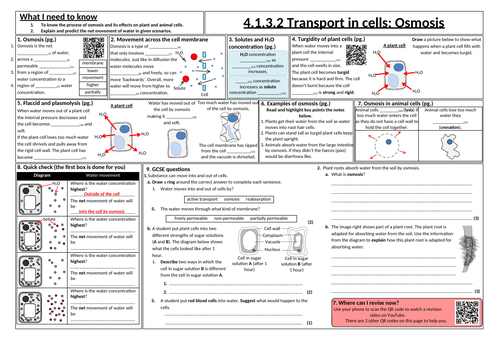
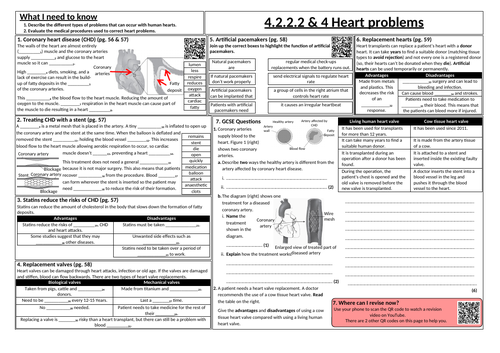
![Response to Exercise and Metabolism [foundation tier]](https://dryuc24b85zbr.cloudfront.net/tes/resources/12858185/image?width=500&height=500&version=1687934898405)
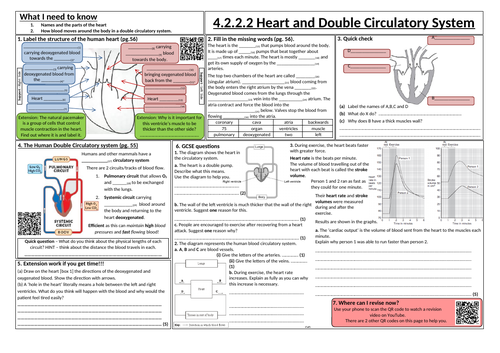
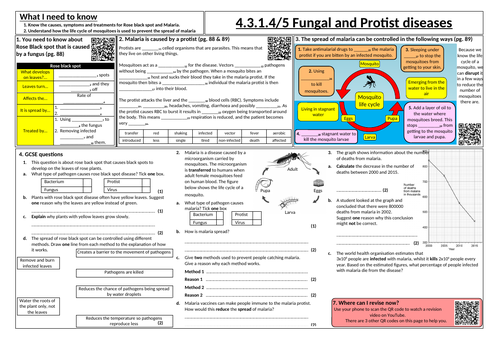
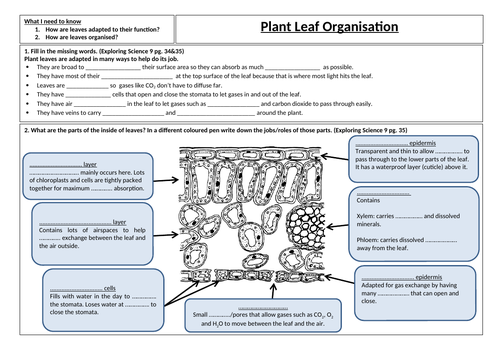
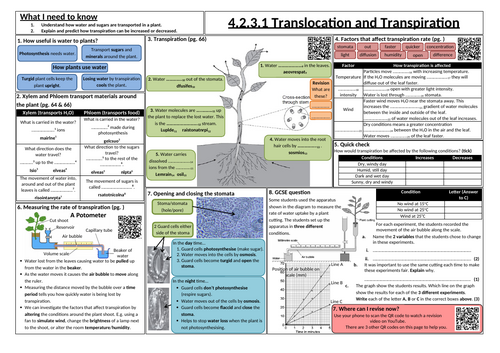
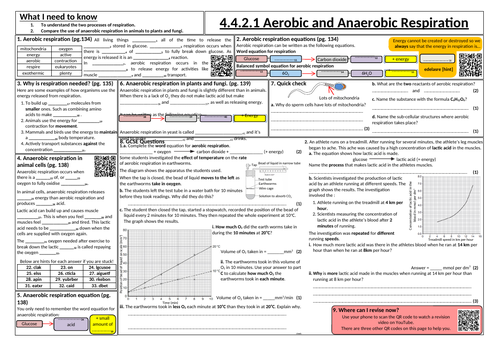
![RPA Photosynthesis [pondweed - higher tier]](https://dryuc24b85zbr.cloudfront.net/tes/resources/12707589/image?width=500&height=500&version=1687935015932)
![RPA Photosynthesis [pondweed]](https://dryuc24b85zbr.cloudfront.net/tes/resources/12707585/image?width=500&height=500&version=1687935033523)
